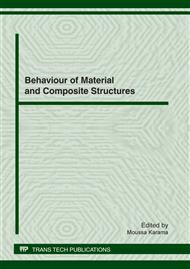[1]
E. F Rybicki , M. F Kanninen, : A finite element calculation of stress intensity factors by modified crack closure integral. Engineering Fracture Mechanics 9, (1977), pp.931-938.
DOI: 10.1016/0013-7944(77)90013-3
Google Scholar
[2]
Whitney, J.M. Experimental characterization of delamination fracture. In Interlaminar Response of Composite Materials, ed N. J Pagano. Elsevier, London 1989, pp.161-250.
DOI: 10.1016/b978-0-444-87285-2.50008-x
Google Scholar
[3]
Olsson, R. A simplified improved beam anlysis of the DCB specimen. In Composites Science and Technology. ed Bryan, H. Vol 43 No 4 (1992), pp.329-338.
DOI: 10.1016/0266-3538(92)90056-9
Google Scholar
[4]
J. H Crews, J.R. Reeder: A mixed-mode bending apparatus for delamination testing. NASA Technical Memorandum 100662. August (1988).
Google Scholar
[5]
American Society for Testing and Materials (ASTM): Standards Test Methods for Mode I Interlaminar Fracture Toughness of Unidirectional Fiber-Reinforced Polymer Matrix Composites, ASTM D5528-94a, May 15, (1994).
DOI: 10.1520/d5528-01
Google Scholar
[6]
European Structural Integrity Society (ESIS), Polymers & Composites Task Group (TC4): Protocols for Interlaminar Fracture Testing of Composites. No. 1-4, April (1992).
DOI: 10.1016/s1566-1369(00)x8001-6
Google Scholar
[7]
Davidson, B. D. & Schapery, R. A., Effect of finite width on deflection and energy release rate of an orthotropic double cantilever specimen. J. Comp. Mat 22(1988), pp.640-656.
DOI: 10.1177/002199838802200704
Google Scholar
[8]
B. D Davidson, R. Kruger, M. Konig : Effect of stacking sequence on ERR distribution in multidirectional DCB and ENF specimens. Eng. fract. Mech. Volume 55, Issue 4, 1996, pp.557-569.
DOI: 10.1016/s0013-7944(96)00037-9
Google Scholar
[9]
Irwin, G.R., Handbuch der Physik, Springer, Berlin, 1958, Vol 6, pp.551-590.
Google Scholar
[10]
Davidson, B.D.: An analytical investigation of delamination front curvature in double cantilever beam specimens. Journal of Composite Materials, Vol. 24- No. 11, 1990, pp.1124-1137.
DOI: 10.1177/002199839002401101
Google Scholar
[11]
Davidson, B.D., Koudela, L.: Influence of mode mix of precracking on the delaminaion toughness of laminated composites. Journal of Reinforced Plastics and composites, Vol. 18, No. 15/1999, pp.1408-1414.
DOI: 10.1177/073168449901801504
Google Scholar
[12]
Gay. Matériaux composites. 4e éd. Paris: Hermès, 1997, (Materiaux). ISBN 2-86601-586- X. pp.289-332.
Google Scholar
[13]
H. Okada, H. Kawai, K. Araki: Engineering Fracture Mechanics 75 (2008) 4466– 4485.
Google Scholar
[14]
R. Krueger: NASA/CR-2002-211628. ICASE Report No. 2002- 10.
Google Scholar


